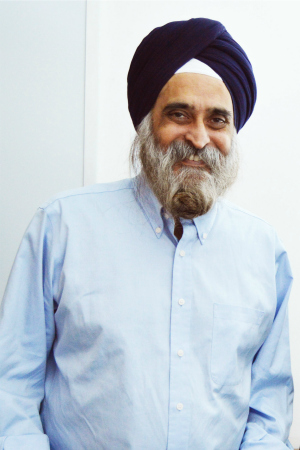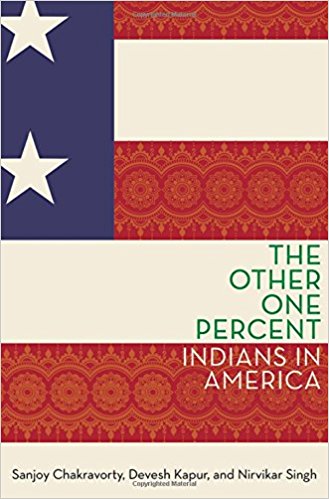At a moment when immigration to the United States is being challenged at the highest levels of government, the experience of Indian immigrants in America offers valuable lessons about the mutual benefits of open borders.
Indian Americans are the wealthiest and most highly educated immigrants in the country. But there's nothing special about Indians per se, according to Economics Professor Nirvikar Singh, coauthor of The Other One Percent: Indians in America.
Since 1965, the selection process in India has favored the most privileged members of society—those from the educated, upper classes—and U.S. immigration policies further advantaged high-achieving students and skilled workers.
"There is no 'secret sauce.' There are no peculiarly Indian cultural traits," said Singh. "They came very carefully selected. They were not coming from poverty. The simplest policy prescription may be this: Make sure everyone has access to education."
Coauthored with Sanjoy Chakravorty, a geographer, and Devesh Kapur, a political scientist, The Other One Percent: Indians in America (Oxford University Press, 2016), breaks down the fascinating story of how a population from a poor developing country with low education became the most educated, highest-income group in the world's most advanced nation—in a single generation.
Now numbering more than 3 million, people of Indian origin make up 1 percent of the U.S. population—hence the book's title—and would surge to 2 percent by 2030, if current trends were to continue. More than 75 percent have arrived since the 1990s.
The flow of Indians to the United States began in 1965, when the U.S. relaxed its immigration policies. Coming disproportionately from the upper castes, those early migrants sought educational and employment opportunities that set in motion a pattern of success that would be replicated across generations:
• 68 percent of India-born immigrants living in the U.S. have college degrees;
• Indian immigrants are concentrated in industries like information technology;
• Their average incomes are generally higher than the average incomes associated with their level of educational attainment;
• Rates of self-employment and entrepreneurship are higher at both the high and low ends of the income scale, reflecting engagement in both hospitality and retail, as well as medicine and the high-tech industry;
• Though Indians make up 1 percent of the population, they comprise 8 percent of the founders of high-tech companies—and one-third of technology startups in Silicon Valley.
"Indian American entrepreneurship has been quite prominent," said Singh, whose contributions to the book included the role of entrepreneurship in the success of Indian immigrants. "It's a very important engine of economic growth."
Indian immigrants who were shut out of corporate jobs and professions because of discrimination followed one classic immigrant path, starting out in retail, hotels, restaurants, and convenience stores. Nevertheless, many of them emerged as entrepreneurial "success stories," said Singh: "Someone who started out working in a gas station might end up owning twelve of them."
However, Indian migrants who come to the United States as refugees and those who enter the country illegally—lacking education and legal status—have a much harder time adjusting.
"Your path to success as an immigrant depends a lot on what you bring in and what your constraints are in your new home," he said. "Without educational resources and a stable financial background, migrants typically get stuck. Socioeconomic factors are much more determining than any cultural traits."
The future of immigration policy is more fraught today than at any time in recent memory, noted Singh. How Indians in America—as well as those who aspire to come to the U.S.—will be impacted remains to be seen.
"Economists talk about 'social capital'—basically, who you know— and 'human capital'—the value of education," he added. "In the United States, a major barrier to social mobility is inequality of access to education. That's a persistent challenge. That lack of social and income mobility is the core of the '1 percent' problem of income inequality in this country."
Looking broadly at the U.S. economy, Singh describes the end of the post-World War II boom fueled by global trade and open capital markets—and anticipates dramatic changes that will dictate workforce needs.
"In some ways, we have reached the peak of the era of big corporations," he said. "Because technology and the economic structure are changing, the era of big corporations employing large numbers is ending."
The next wave of major structural changes in the economy will be driven by information technology and by climate change, both of which will drive changes in how energy is generated and consumed, Singh predicted.
"We want a system that prepares young people for a drastically different economy than their parents experienced," he said. "Immigration policy has allowed the United States to skim the educational cream of Indian society in STEM fields that will be important for this structural transformation. In some sense, Indian Americans have been filling a gap in the American system. I don't think President Trump appreciates the importance of science and technology education."
Politically, Indian Americans identify as Democrats by a margin of 10:1, and population growth suggests they could play key roles as swing voters in Texas and Georgia in the next decade and beyond. Today, 80 percent of second-generation Indian Americans are under the age of 25, which means many are only beginning to exert their influence on U.S. society.
Singh says there is another dimension to the story: "It's really about what kind of America do we want, as Americans," he said. "We've been heading toward an America that is more pluralistic. The Indian American story is one window on that bigger issue."




